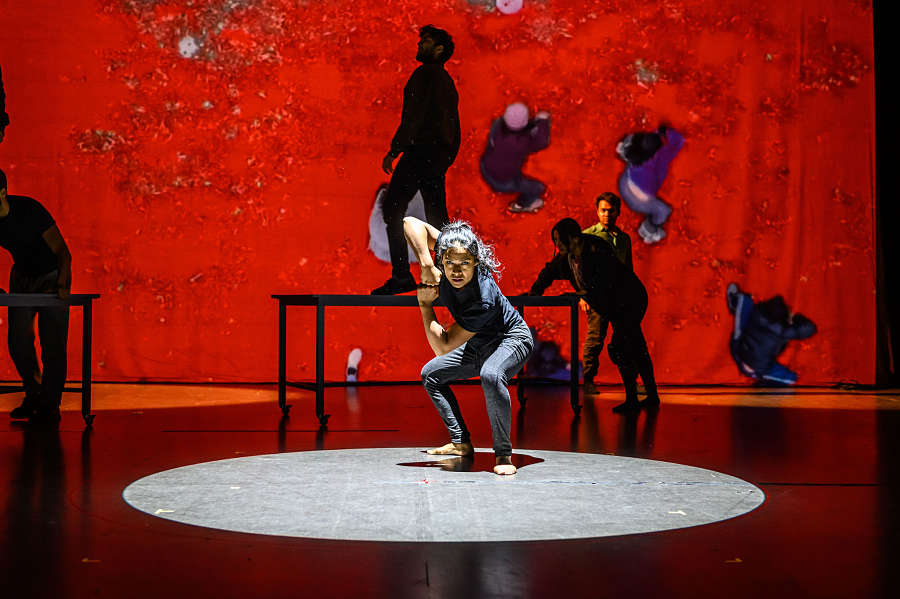Audiences in the West know the Indian epic the Mahabharata, if they know it at all, via Peter Brook and Jean-Claude Carrière’s groundbreaking nine-hour stage adaptation, originally staged in France in 1985, then in Brooklyn in 1987, and finally filmed in 1989. Billed as an “international” production, it had a multiracial cast and toured widely around the world, but it was unavoidably and properly received as a Western “take” on the saga.
In India and among the Indian diaspora, of course, this 4,000-year-old Sanskrit epic is more than just a story, though in popular culture it has taken the form of a popular comic book and a 94-part television series, and is performed and/or told, formally and informally, in a variety of settings. As director Ravi Jain of Toronto’s Why Not Theatre told me recently, “Most of how we experience it is around the dinner table with food, and you’ll get one story out of context.”
The occasion for my chat with Jain is a sprawling new production Jain has created with Miriam Fernandes, using poetry from Carole Satyamurti’s Mahabharata: A Modern Retelling, among other sources, which will premiere in two parts at the Shaw Festival in Niagara-on-the-Lake, Ontario, Aug. 15-Sept. 19. (The original concept was developed with Jenny Koons). Unlike Brook’s production, the new Mahabharata will feature an entirely South Asian cast, though Jain was quick to note that the show’s 12 actors and 6 band members hail from “all over the U.K., Australia, Malaysia, India, and across Canada—from the entire diaspora. So it’s also an international ensemble.”

Funded by a “big grant” from the Canada Council for the Arts’ New Chapter initiative, this new Mahabharata—essentially the tale of a vast, multi-generational family feud—starts out small and grows big, Jain said.
“We start from the fire, sitting around a circle, and go to shadow puppets, to masks, to physical theatre and street performance, then jump 4,000 years ahead to the most contemporary projections and live feeds,” he said of the production’s evolving aesthetic. (Production design is by Camellia Koo, lighting is by Kevin Lamotte, projections are by Hana S. Kim, sound is by Suba Sankaran and John Gzowski, music is by Suba Sankaran and John Gzowski, with Ed Hanley and Hasheel Lodhia.) In between the two parts on two-show days, a shared meal will be offered at intermission, with a community volunteer sharing a story. Amid the high theatrics and drama, this interval, Jain said, is designed to “approximate the feeling of the way the story is experienced through most of the South Asian diaspora—you don’t ever sit and see the Mahabharata from beginning to end.”

Beginnings and endings are definitely central in this tale, and as such contemporary parallels aren’t hard to find. The production’s first part, Karma: The Life We Inherit, tells the origin story of the rival Pandava and Kaurava clans, while the second part, Dharma: The Life We Choose, tells the story of a vast battle that ends the world as we know it. Both parts, Jain said, reflect and are informed by “climate crisis we’re in, and what are the stories we tell ourselves to build the new world? It starts with us imagining the first 800 people on the planet, and then we get to a point where we imagine we’re the last 800 people in the planet—the survivors of a huge mass extinction.”
To be clear, this shouldn’t be mistaken for a “traditional” take on the Mahabharata, or even a specifically or exclusively Indian one. While, as Jain pointed out, “The West hasn’t seen a South Asian company tell the story,” he also conceded that “we are a hybrid of South Asian/not South Asian.” Jain himself was raised with “Chewbacca and Han Solo posters on my wall and pictures of Krishna in the home,” and his theatre training was at NYU and with Lecoq in France. And many of the South Asian cast members are “learning the story for the first time.” But what he and they have discovered in the rehearsal room is “that the story really connects us to this idea of another time and place, and in a way we know these stories.”
Indeed the more he and his diversely educated company dig into the style and form of the storytelling, the more they uncover the common roots of live performance: Dance theatre inevitably leads back to Bharatnatyam, one of its oldest manifestations. And Western mime and clowning, not to mention the hugely influential practices of such European auteurs as Peter Brook and Ariane Mnouchkine, owe huge debts to non-Western theatre. “Those traditions of the West are actually East if you go far back enough in time,” Jain said.
For more information about the Shaw Festival’s staging of Mahabharata, go here.


